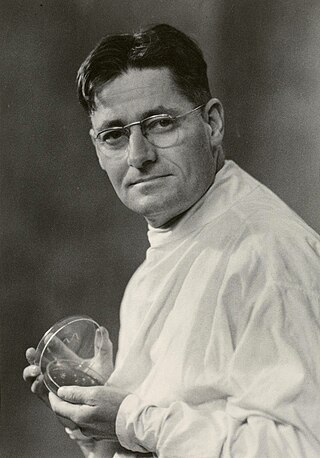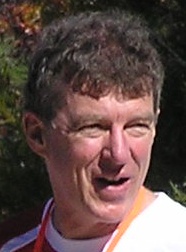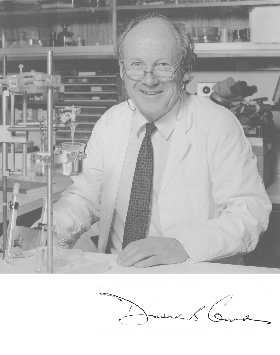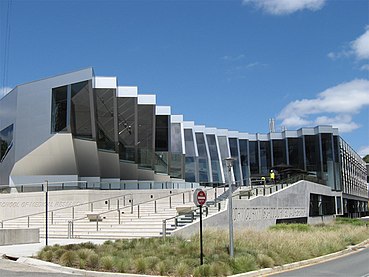
Sir John Carew Eccles was an Australian neurophysiologist and philosopher who won the 1963 Nobel Prize in Physiology or Medicine for his work on the synapse. He shared the prize with Andrew Huxley and Alan Lloyd Hodgkin.

Howard Walter Florey, Baron Florey, was an Australian pharmacologist and pathologist who shared the Nobel Prize in Physiology or Medicine in 1945 with Ernst Chain and Sir Alexander Fleming for his role in the development of penicillin.

WEHI, previously known as the Walter and Eliza Hall Institute of Medical Research, and as the Walter and Eliza Hall Institute, is Australia's oldest medical research institute. Sir Frank Macfarlane Burnet, who won the Nobel Prize in 1960 for his work in immunology, was director from 1944 to 1965. Burnet developed the ideas of clonal selection and acquired immune tolerance. Later, Professor Donald Metcalf discovered and characterised colony-stimulating factors. As of 2015, the institute hosted more than 750 researchers who work to understand, prevent and treat diseases including blood, breast and ovarian cancers; inflammatory diseases (autoimmunity) such as rheumatoid arthritis, type 1 diabetes and coeliac disease; and infectious diseases such as malaria, HIV and hepatitis B and C.

Sir Gustav Victor Joseph Nossal is an Austrian-born Australian research biologist. He is famous for his contributions to the fields of antibody formation and immunological tolerance.

Peter Charles Doherty is an Australian immunologist and Nobel laureate. He received the Albert Lasker Award for Basic Medical Research in 1995, the Nobel Prize in Physiology or Medicine jointly with Rolf M. Zinkernagel in 1996 and was named Australian of the Year in 1997. In the Australia Day Honours of 1997, he was named a Companion of the Order of Australia for his work with Zinkernagel. He is also a National Trust Australian Living Treasure. In 2009 as part of the Q150 celebrations, Doherty's immune system research was announced as one of the Q150 Icons of Queensland for its role as an iconic "innovation and invention".

Rolf Martin Zinkernagel AC is a professor of experimental immunology at the University of Zurich. Along with Peter C. Doherty, he shared the 1996 Nobel Prize in Physiology or Medicine for the discovery of how the immune system recognizes virus-infected cells.
Jacques Francis Albert Pierre Miller AC FRS FAA is a French-Australian research scientist. He is known for having discovered the function of the thymus and for the identification, in mammalian species of the two major subsets of lymphocytes and their function.

Ian Hector Frazer is a Scottish-born Australian immunologist, the founding CEO and Director of Research of the Translational Research Institute (Australia). Frazer and Jian Zhou developed and patented the basic technology behind the HPV vaccine against cervical cancer at the University of Queensland. Researchers at the National Cancer Institute, Georgetown University, and University of Rochester also contributed to the further development of the cervical cancer vaccine in parallel.
Gordon Leslie Ada AO, FAA was an Australian biochemist best known for his seminal contributions to virology and immunology and his long leadership of the Department of Microbiology at the John Curtin School of Medical Research at the Australian National University, where Peter C. Doherty and Rolf Zinkernagel performed their Nobel winning research in his department. Both Zinkernagel and Doherty held him in high regard, and he was invited by them to attend the Nobel award ceremony and dinner in Stockholm.
Suzanne Cory is an Australian molecular biologist. She has worked on the genetics of the immune system and cancer and has lobbied her country to invest in science. She is married to fellow scientist Jerry Adams, also a WEHI scientist, whom she met while studying for her PhD at the University of Cambridge, England.
The Ian Constable Lecture is an annual lecture given in Perth, Western Australia.

Philippa "Pippa" Marrack, FRS is an English immunologist and academic, based in the United States, best known for her research and discoveries pertaining to T cells. Marrack is the Ida and Cecil Green Professor and chair of the Department of Biomedical Research at National Jewish Health and a distinguished professor of immunology and microbiology at the University of Colorado Denver.
The Sir William Dunn School of Pathology is a department within the University of Oxford. Its research programme includes the cellular and molecular biology of pathogens, the immune response, cancer and cardiovascular disease. It teaches undergraduate and graduate courses in the medical sciences.

David Roderick Curtis AC MB BS PhD FRACP FAA FRS was an Australian pharmacologist and neurobiologist.
Judith Ann Whitworth is an Australian medical researcher in the areas of kidney function and blood pressure. Now an emeritus professor, she is the former director of the John Curtin School of Medical Research and Howard Florey Professor of Medical Research at the Australian National University (ANU).
Professor Anne Kelso is an Australian biomedical researcher specialising in immunology and influenza. She is the Chief Executive Officer of the Australian Government's National Health and Medical Research Council (NHMRC).

The ANU College of Health & Medicine is an Australian university college for the study of medicine, psychology, mental health, epidemiology and population health at the Australian National University (ANU), located in Canberra, the capital city of Australia.

The MRC Weatherall Institute of Molecular Medicine at the University of Oxford is a research institute located at the John Radcliffe Hospital in Oxford. Founded in 1989 by Sir David Weatherall, the institute focuses on furthering our understanding of clinical medicine at a molecular level. It was one of the first institutes of its kind in the world to be dedicated to research in this area.

Frank William Ernest Gibson was an Australian biochemist and molecular biologist, Howard Florey Professor of Medical Research in the John Curtin School of Medical Research, and a Fellow of the Royal Society of London He undertook his most notable work at the University of Melbourne. He and his research group were responsible for the discovery of chorismic acid. He later worked at The Australian National University (ANU).

George Bellamy Mackaness was an Australian professor of microbiology, immunologist, writer and administrator, who researched and described the life history of the macrophage. He showed that by infecting mice with intracellular bacteria, macrophages could be activated to attack other bacteria, triggering further research on "macrophage activation", a term he has come to be associated with.













